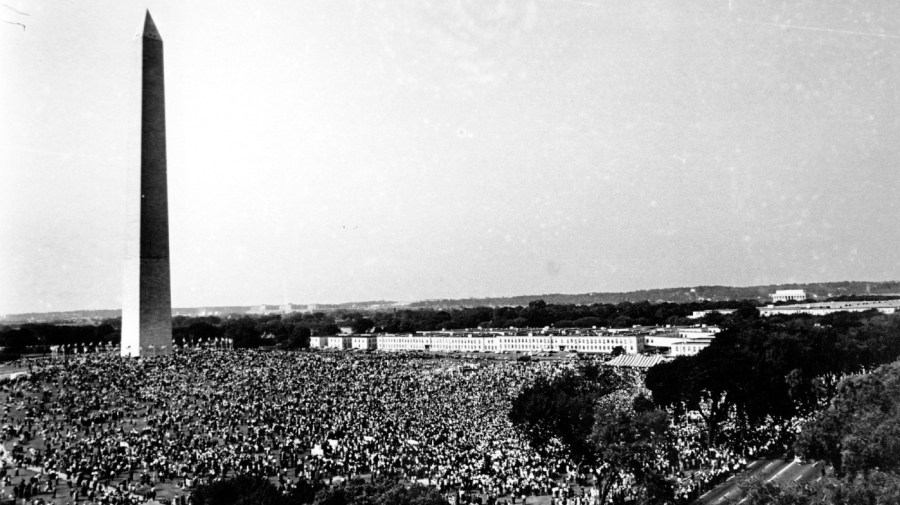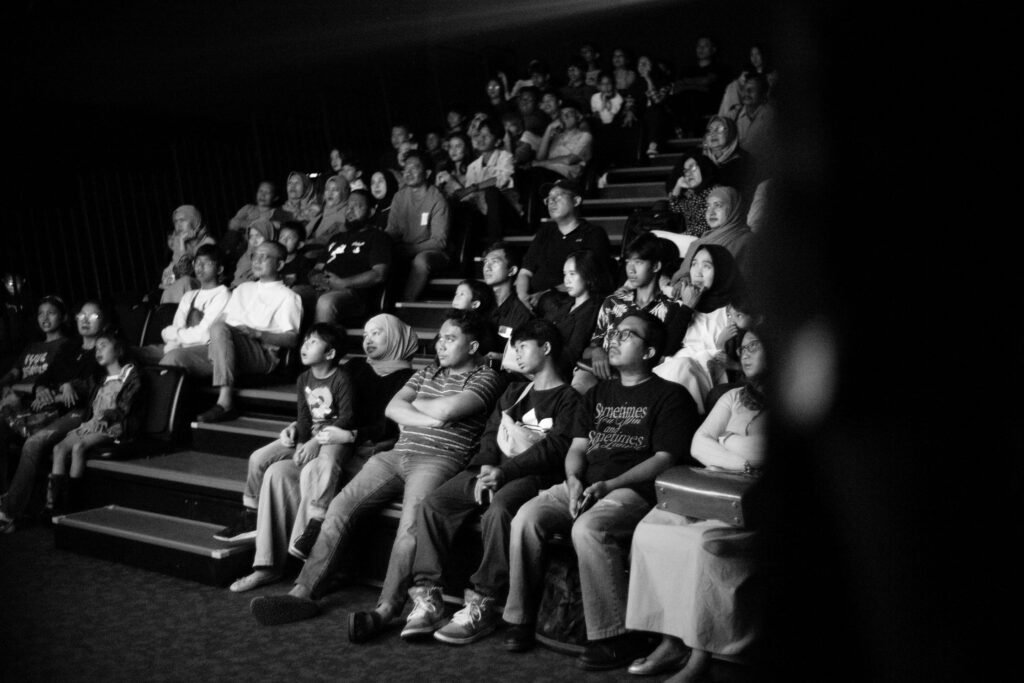Business
Fight for economic equity under ‘assault’ 60 years after March on Washington, advocates warn on August 24, 2023 at 10:00 am Business News | The Hill

Sixty years after civil rights leaders demanded equal access to employment and fair wages for Black Americans at the historic March on Washington for Jobs and Freedom, economic equity is still far from a reality in the U.S.
While advocates acknowledge that some strides have been made in the decades since the march, notable gaps persist between Black and white Americans in areas such as wealth and income, joblessness and homeownership.
And concern is mounting that further progress could be threatened amid rising racial tensions.
“We are strongly not on the path of bridging inequality,” said Dedrick Asante-Muhammad, chief of Race, Wealth and Community for the National Community Reinvestment Coalition (NCRC).
“I think oftentimes, people approach it like, ‘Oh, we’re almost there. There’s a few things we got to do,’” he said. But, he argued, “We are on a very clear path of ongoing Black-white economic apartheid for centuries — unless we do radical policy change.”
Glaring disparities persist decades later
Roughly 250,000 people gathered for the march on Aug. 28, 1963, with a list of demands from Washington for effective policy combatting discrimination in federal programs and in labor, including calls for a “decent” minimum wage, housing and education for all Americans.
Decades later, experts and advocates point to significant remaining disparities between races.
The racial wealth gap has narrowed only slightly since the march. The ratio between white and Black wealth per capita saw a notable decline in the years following emancipation, according to a June 2022 paper published by the National Bureau of Economic Research. In 1860, that ratio stood at roughly 60-to-1. By the 1920s, it was down to 10-to-1.
But it decreased much more slowly in the years that followed, reaching 7-to-1 in the 1950s before inching to “a similar magnitude of 6-to-1” roughly seven decades later.
Among the factors that likely slowed progress in closing the gap, the report cites the revival of the Ku Klux Klan in the 1920s and the nation’s lengthy history of racist laws and practices, ranging from political disenfranchisement of Black Americans to Jim Crow-era policies.
“You have to be honest about these policies and their impacts,” said Algernon Austin, the Director for Race and Economic Justice at the Center for Economic and Policy Research. “And then when you fail to do that, then people who have political agendas to maintain, frankly, to maintain white supremacy, then can attack all these attempts at remediation.”
Other economic disparities have also persisted into the present day. Among Americans who are employed, research from the Economic Policy Institute (EPI) showed the typical Black worker made more than 24 percent less than their white counterparts per hour in 2019 — a figure the group noted was about 8 percentage points higher than it was four decades earlier.
There is much more work to be done to address the Black-white homeownership gap, advocates add. A 2022 report from the National Association of Real Estate Brokers found the Black homeownership rate had “only modestly” increased since the 1968 passage of the Fair Housing Act, while the racial homeownership gap has widened over the years.
The report found the homeownership disparity between Black and white Americans, which sat at 23.8 percent in 1970, reached more than 31 percent five decades later. It said the gap hit 30 percent in 2022, continuing what the group called “a two-decades long trend of an expanding homeownership gap between Blacks and whites.”
“We have housing disparities that are wider than they were during Jim Crow,” said Samantha Tweedy, chief executive officer for the Black Economic Alliance, in an interview, calling housing “one of the foremost drivers of wealth in this country.”
Earlier this year, the White House cheered data showing the Black unemployment rate fell to a historic low in March, with Bharat Ramamurti, deputy director of the White House National Economic Council, calling the news an “incredible milestone” in remarks to TheGrio at the time.
“President [Biden] and Vice President [Harris], from the moment that they came into office, identified that they not only wanted to have a strong economic recovery, they wanted to have an equitable recovery,” Ramamurti said then.
The rate hit 5 percent in March, compared to a 3.2 percent unemployment rate for white Americans, and fell again in April, reaching 4.7 percent, before seeing upticks in the following months. But advocates are pushing for more sustained improvements.
“You can’t draw any conclusions from one month of numbers,” National Urban League President Marc Morial said. “The issue is, is the gap now over a one-, two-, three-year period?”
“While I like to see the gap narrow, I’m not popping a cork on one or two months of a narrower gap,” he added, adding: “We have to measure these things in sustainability.”
At the same time, experts have pointed to some progress the nation has made toward racial economic equality over a longer time, including headway in educational attainment and an overall drop in the poverty rate for Black Americans — which data from EPI shows declined more than 12 percent between 1968, when it sat at 34.7 percent, and 2016.
“In 1962, whites had about 2.4 times the four-year college attainment level of Blacks,” Asante-Muhammad said, while discussing the racial gap in higher education. “In 2022, it’s 1.7. So still, serious disparities, but there has been some bridging over those years.”
However, he also notes African Americans with college degrees don’t have equal levels of employment to their white counterparts, nor “have equal income levels and really don’t have equal wealth levels.”
“Even with kind of solid educational attainment, even with less segregation, more civil rights laws, we still see this massive income inequality that, if it continued to improve, as it has been since 1963, it would take us over 500 years for Blacks just to get income equality with whites,” he argued.
Research shows views of capitalism have shifted among Black Americans over the years, with a 2022 survey from the Pew Research Center finding 54 percent of Black adults said “they had a very or somewhat negative impression of capitalism.” The number is a 14-percentage-point jump from 2019.
“The question is, is it working for me?” Morial said of the findings. “That’s the issue.”
“People are saying, well, if I don’t think I’ve got a fair wage, well, they’re gonna tell you they don’t think the economic system’s working for them,” he said. “It’s less of a philosophical question and more of a practical question.”
‘A threat to progress’
There is concern among advocates and experts that an increased focus by conservatives on affirmative action and diversity initiatives could add greater hurdles to the battle for economic equality in the years ahead.
“The biggest threat is the right-wing assault on the policies which have made a difference,” National Urban League president Marc Morial said. “They’ve not made enough of a difference, but they’ve made a difference. It’s an assault by right-wing interests.”
From GOP-led efforts restricting how race is taught in schools across the country to those targeting affirmative action, advocates have been sounding alarms over what they see as a backlash to initiatives aimed at improving racial diversity and inclusion that gained momentum during the months of global protests against police brutality following the murder of George Floyd in 2020.
Bills have also gained traction in the Republican House majority that seek to take aim at diversity training and efforts to increase representation as part of a larger so-called “anti-woke” push proponents say is needed to tackle unfair and unnecessary race initiatives.
“When you’re trying to reduce some of this burden that’s been placed on these victims of racial subjugation, and you’re calling that racist, it’s racist to call that racist,” Austin said.
“That’s the problem in this society, which is in fact why we need to talk about race more, and more honestly, because we live in a society where being white has been a positive, has given you preferences in varieties of ways,” he said, citing the impact of redlining, segregation, criminal justice policies and underfunding schools in the Black community.
The road ahead
Experts say a combination of race-conscious policies and broader measures like wage and labor reform is necessary to narrow racial economic gaps. But some have doubts about how far national leaders are willing to go to address those disparities, given history.
A recent report from the NCRC estimated it would take more than 500 years for Black Americans to reach the white median household income at the pace set in past decades.
“I think the biggest threat is the unwillingness to seriously commit to redistribution of resources, which is what is required to bridge racial inequality,” Asante-Muhammad of the NCRC said — a problem he charged both sides of the aisle with failing to adequately address.
“It’s one thing to take down the segregation sign, it’s another thing to invest in building affordable housing and doing lending in a way that would strongly increase Black homeownership,” he said. “Those are different.”
As the nation marks the 60th anniversary of the March on Washington, advocates say the demands made by the hundreds of thousands of protesters who gathered in the nation’s capital for the event still hold today — including those for better wages and jobs.
“Raising the minimum wage is crucial,” Morial also said. “Increase in job training and education is crucial. Enforcing anti-discrimination laws is crucial.”
“Creating more tools and more of a commitment to homeownership for low and moderate income Americans is crucial,” he said. “Raising and improving access to capital for small businesses and Black small businesses is crucial.”
Asante-Muhammad points to measures congressional lawmakers have introduced that focus on Black homeownership, reparations and asset policies, like the baby bonds proposal championed by Rep. Ayanna Pressley (D-Mass.) and Sen. Cory Booker (D-N.J.), as steps in the right direction in countering economic inequality.
But many experts aren’t holding their breath for significant change anytime soon.
“There used to be a time when there was more agreement on what the basic facts were, that we’re dealing with, and then we could argue about, ‘OK, what’s the appropriate solution?’” said Austin.
“But now, when people are wanting to make up facts, then it’s really hard to have a productive debate over what is the appropriate solution,” he said.
Business Sixty years after civil rights leaders demanded equal access to employment and fair wages for Black Americans at the historic March on Washington for Jobs and Freedom, economic equity is still far from a reality in the U.S. While advocates acknowledge that some strides have been made in the decades since the march, notable gaps…
Business
Why 9 Million Americans Have Left

The Growing American Exodus
Nearly 9 million Americans now live outside the United States—a number that rivals the population of several states and signals a profound shift in how people view the American dream. This mass migration isn’t confined to retirees or the wealthy. Thanks to remote work, digital nomad visas, and mounting pressures at home, young professionals, families, and business owners are increasingly joining the ranks of expats.

Rising Costs and Shrinking Wallets
Living in the US has become increasingly expensive. Weekly grocery bills topping $300 are not uncommon, and everyday items like coffee and beef have surged in price over the last year. Rent, utilities, and other essentials also continue to climb, leaving many Americans to cut meals or put off purchases just to make ends meet. In contrast, life in countries like Mexico or Costa Rica often costs just 50–60% of what it does in the US—without sacrificing comfort or quality.
Health Care Concerns Drive Migration
America’s health care system is a major trigger for relocation. Despite the fact that the US spends more per person on health care than any other country, millions struggle to access affordable treatment. Over half of Americans admit to delaying medical care due to cost, with households earning below $40,000 seeing this rate jump to 63%. Many expats point to countries such as Spain or Thailand, where health care is both affordable and accessible, as a major draw.

Seeking Safety Abroad
Public safety issues—especially violent crime and gun-related incidents—have made many Americans feel unsafe, even in their own communities. The 2024 Global Peace Index documents a decline in North America’s safety ratings, while families in major cities often prioritize teaching their children to avoid gun violence over simple street safety. In many overseas destinations, newly arrived American families report a significant improvement in their sense of security and peace of mind.
Tax Burdens and Bureaucracy
US tax laws extend abroad, requiring expats to file annual returns and comply with complicated rules through acts such as FATCA. For some, the burden of global tax compliance is so great that thousands relinquish their US citizenship each year simply to escape the paperwork and scrutiny.
The Digital Nomad Revolution
Remote work has unlocked new pathways for Americans. Over a quarter of all paid workdays in the US are now fully remote, and more than 40 countries offer digital nomad visas for foreign professionals. Many Americans are leveraging this opportunity to maintain their US incomes while cutting costs and upgrading their quality of life abroad.

Conclusion: Redefining the Dream
The mass departure of nearly 9 million Americans reveals deep cracks in what was once considered the land of opportunity. Escalating costs, inaccessible healthcare, safety concerns, and relentless bureaucracy have spurred a global search for better options. For millions, the modern American dream is no longer tied to a white-picket fence, but found in newfound freedom beyond America’s borders.
Business
Will Theaters Crush Streaming in Hollywood’s Next Act?

Hollywood is bracing for a pivotal comeback, and for movie lovers, it’s the kind of shake-up that could redefine the very culture of cinema. With the freshly merged Paramount-Skydance shaking up its strategy, CEO David Ellison’s announcement doesn’t just signal a change—it reignites the passion for moviegoing that built the magic of Hollywood in the first place.

Theatrical Experience Roars Back
Fans and insiders alike have felt the itch for more event movies. For years, streaming promised endless options, but fragmented attention left many longing for communal spectacle. Now, with Paramount-Skydance tripling its film output for the big screen, it’s clear: studio leaders believe there’s no substitute for the lights, the hush before the opening credits, and the collective thrill of reacting to Hollywood’s latest blockbusters. Ellison’s pivot away from streaming exclusives taps deep into what unites cinephiles—the lived experience of cinema as art and event, not just content.
Industry Pulse: From Crisis to Renaissance
On the financial front, the numbers are as electrifying as any plot twist. After years of doubt, the box office is roaring. AMC, the world’s largest theater chain, reports a staggering 26% spike in moviegoer attendance and 36% revenue growth in Q2 2025. That kind of momentum hasn’t been seen since the heyday of summer tentpoles—and it’s not just about more tickets sold. AMC’s strategy—premium screens, with IMAX and Dolby Cinema, curated concessions, and branded collectibles—has turned every new release into an event, driving per-customer profits up nearly 50% compared to pre-pandemic norms.
Blockbusters Lead the Culture
Forget the gloom of endless streaming drops; when films like Top Gun: Maverick, Mission: Impossible, Minecraft, and surprise hits like Weapons and Freakier Friday draw crowds, the industry—and movie fans—sit up and take notice. Movie-themed collectibles and concession innovations, from Barbie’s iconic pink car popcorn holders to anniversary tie-ins, have made each screening a moment worth remembering, blending nostalgia and discovery. The focus: high-impact, shared audience experiences that streaming can’t replicate.
Streaming’s Limits and Studio Strategy
Yes, streaming is still surging, but the tide may be turning. The biggest franchises, and the biggest cultural events, happen when audiences come together for a theatrical release. Paramount-Skydance’s shift signals to rivals that premium storytelling and box office spectacle are again at the center of Hollywood value creation. The result is not just higher profits for exhibitors like AMC, but a rebirth of movie-going as the ultimate destination for fans hungry for connection and cinematic adventure.

Future Forecast: Culture, Community, and Blockbuster Dreams
As PwC and others warn that box office totals may take years to fully catch up, movie lovers and industry leaders alike are betting that exclusive theatrical runs, enhanced viewing experiences, and fan-driven engagement are the ingredients for long-term recovery—and a new golden age. The Paramount-Skydance play is more than a business move; it’s a rallying cry for the art of the theatrical event. Expect more big bets, more surprises, and—finally—a long-overdue renaissance for the silver screen.
For those who believe in the power of cinema, it’s a thrilling second act—and the best seat in the house might be front and center once again.
Business
Why Are Influencers Getting $7K to Post About Israel?

Influencers are being paid as much as $7,000 per post by the Israeli government as part of an expansive and sophisticated digital propaganda campaign. This effort is designed to influence global public opinion—especially among younger social media users—about Israel’s actions in Gaza and to counter critical narratives about the ongoing humanitarian situation.

How Much Is Being Spent?
Recent reports confirm that Israel has dedicated more than $40 million this year to social media and digital influence campaigns, targeting popular platforms such as TikTok, YouTube, and Instagram. In addition to direct influencer payments, Israel is investing tens of millions more in paid ads, search engine placements, and contracts with major tech companies like Google and Meta to push pro-Israel content and challenge critical coverage of issues like the famine in Gaza.
What’s the Strategy?
- Influencer Contracts: Influencers are recruited—often with all-expenses-paid trips to Israel, highly managed experiences, and direct payments—to post content that improves Israel’s image.
- Ad Campaigns: State-backed ad buys show lively Gaza markets and restaurants to counter global reports of famine and humanitarian crisis.
- Narrative Management: These posts and ads often avoid overt propaganda. Instead, they use personal stories, emotional appeals, and “behind the scenes” glimpses intended to humanize Israel’s side of the conflict and create doubt about reports by the UN and humanitarian agencies.
- Amplification: Paid content is strategically promoted so it dominates news feeds and is picked up by news aggregators, Wikipedia editors, and even AI systems that rely on “trusted” digital sources.
Why Is This Happening Now?
The humanitarian situation in Gaza has generated increasing international criticism, especially after the UN classified parts of Gaza as experiencing famine. In this environment, digital public relations has become a primary front in Israel’s efforts to defend its policies and limit diplomatic fallout. By investing in social media influencers, Israel is adapting old-school propaganda strategies (“Hasbara”) to the era of algorithms and youth-driven content.
Why Does It Matter?
This campaign represents a major blurring of the lines between paid promotion, journalism, and activism. When governments pay high-profile influencers to shape social media narratives, it becomes harder for audiences—especially young people—to distinguish between authentic perspectives and sponsored messaging.

In short: Influencers are getting $7,000 per post because Israel is prioritizing social media as a battleground for public opinion, investing millions in shaping what global audiences see, hear, and believe about Gaza and the conflict.

 Business4 weeks ago
Business4 weeks agoDisney Loses $3.87 Billion as Subscription Cancellations Surge After Kimmel Suspension

 Entertainment4 weeks ago
Entertainment4 weeks agoWhat the Deletion Frenzy Reveals in the David and Celeste Tragedy

 Entertainment4 weeks ago
Entertainment4 weeks agoExecutive Producer Debut: How Celia Carver Created Festival Hit ‘Afterparty’

 Health4 weeks ago
Health4 weeks agoRussia Claims 100% Success With New mRNA Cancer Vaccine

 Business3 weeks ago
Business3 weeks agoWhy Are Influencers Getting $7K to Post About Israel?

 Health4 weeks ago
Health4 weeks agoWhy Did Gen Z QUIT Drinking Alcohol?

 Advice4 weeks ago
Advice4 weeks agoHow AI Is Forcing Everyone Into the Entrepreneur Game

 Entertainment3 weeks ago
Entertainment3 weeks agoKeith Urban and Nicole Kidman Split After 20 Years as Actress Files for Divorce




























